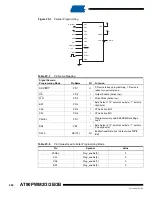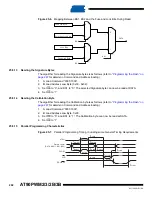
298
4317I–AVR–01/08
AT90PWM2/3/2B/3B
Note:
a = address high bits, b = address low bits, H = 0 - Low byte, 1 - High Byte, o = data out, i = data in, x = don’t care
25.9.4
SPI Serial Programming Characteristics
For characteristics of the SPI module see “SPI Serial Programming Characteristics” on page
298.
Write Fuse High bits
1010 1100
1010 1000
xxxx xxxx
iiii iiii
Set bits = “0” to program, “1” to
unprogram. See
for details.
Write Extended Fuse Bits
1010 1100
1010 0100
xxxx xxxx
xxxx xxii
Set bits = “0” to program, “1” to
unprogram. See
for details.
Read Fuse bits
0101 0000
0000 0000
xxxx xxxx
oooo oooo
Read Fuse bits. “0” = programmed, “1”
= unprogrammed. See Table XXX on
page XXX for details.
Read Fuse High bits
0101 1000
0000 1000
xxxx xxxx
oooo oooo
Read Fuse High bits. “0” = pro-
grammed, “1” = unprogrammed. See
for details.
Read Extended Fuse Bits
0101 0000
0000 1000
xxxx xxxx
oooo oooo
Read Extended Fuse bits. “0” = pro-
grammed, “1” = unprogrammed. See
for details.
Read Calibration Byte
0011 1000
000x xxxx
0000 0000
oooo oooo
Read Calibration Byte
Poll RDY/BSY
1111 0000
0000 0000
xxxx xxxx
xxxx xxx
o
If o = “1”, a programming operation is
still busy. Wait until this bit returns to
“0” before applying another command.
Table 25-16. Serial Programming Instruction Set (Continued)
Instruction
Instruction Format
Operation
Byte 1
Byte 2
Byte 3
Byte4
















































